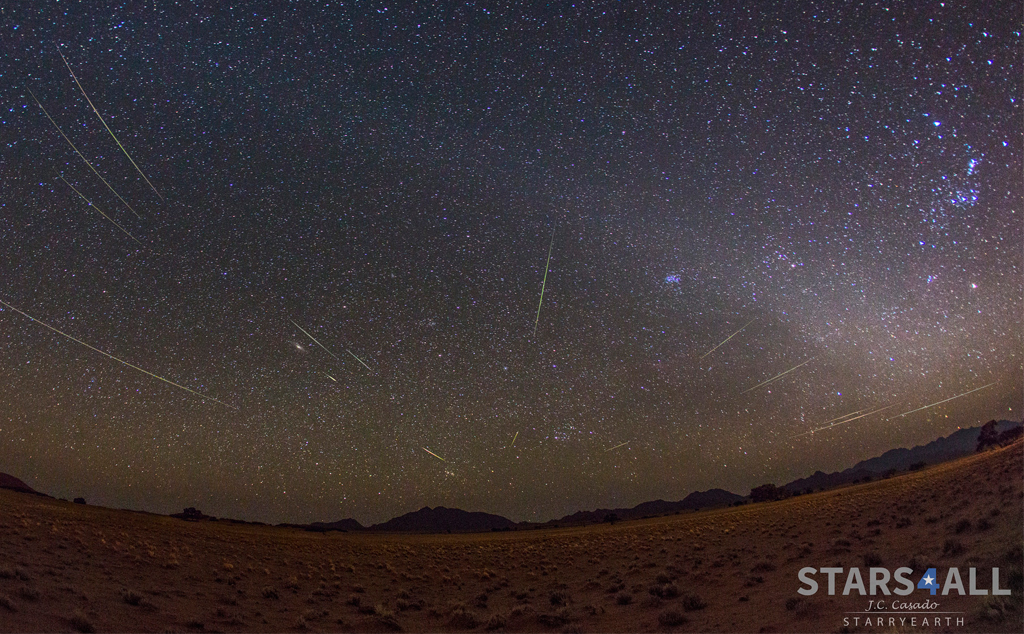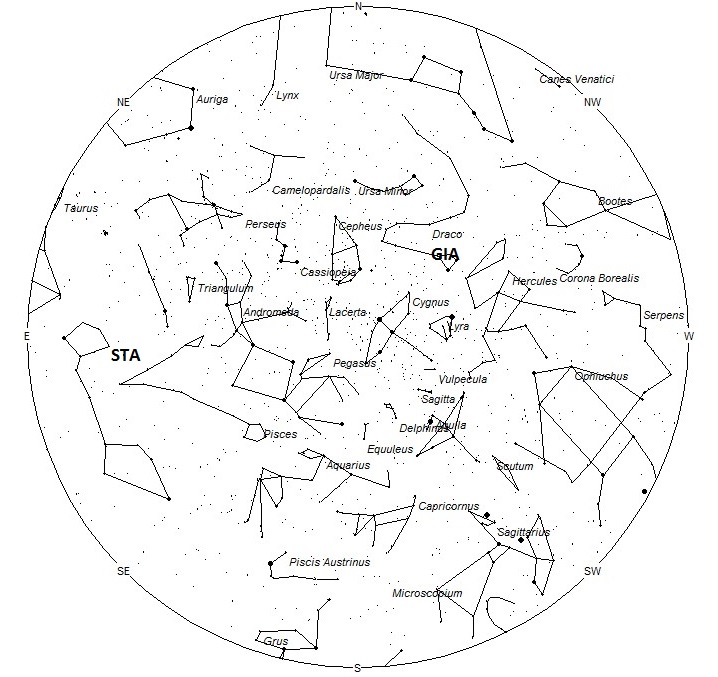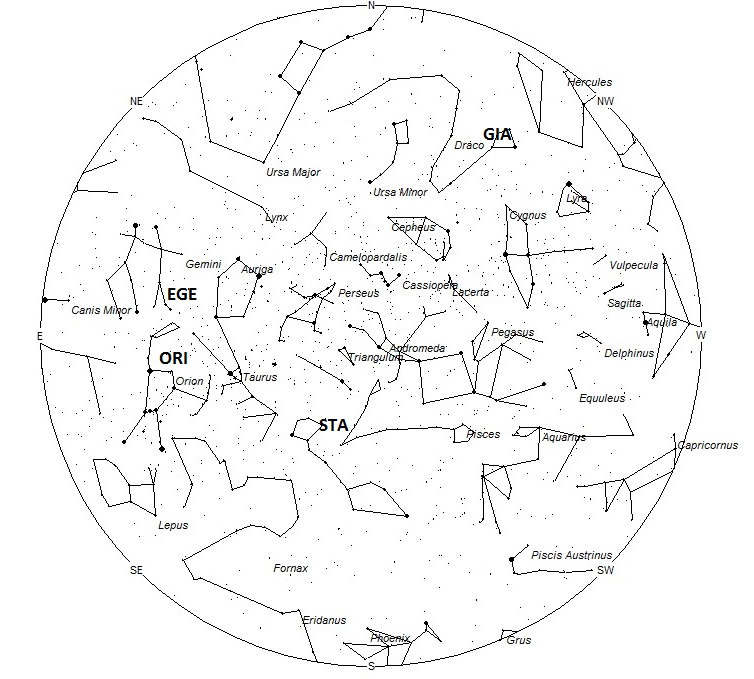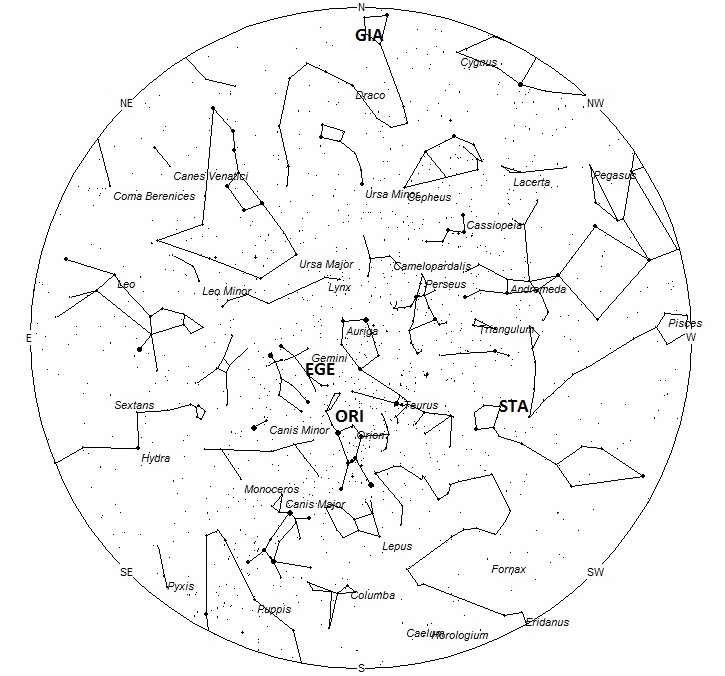
During this period the moon reaches it first quarter phase on Saturday October 8th. At this time the moon will be located 90 degrees east of the sun and will set near midnight local daylight saving time (LDT). This weekend is favorable for meteor observing as the more active morning hours will be free of interfering moonlight. As the week progresses the waxing gibbous moon will begin to interfere during the morning hours as it sets later and later with each passing night. Toward the end of this period the moon will remain above the horizon most of the night making meteor observing difficult as the lunar glare overpowers all but the brighter meteors. The estimated total hourly meteor rates for evening observers this week is near 3 as seen from mid-northern latitudes (45N) and 2 as seen from tropical southern locations (25S). For morning observers the estimated total hourly rates should be near 21 as seen from mid-northern latitudes (45N) and 16 as seen from tropical southern locations (25S). The actual rates will also depend on factors such as personal light and motion perception, local weather conditions, alertness and experience in watching meteor activity. Evening rates are reduced this week due to moonlight. Note that the hourly rates listed below are estimates as viewed from dark sky sites away from urban light sources. Observers viewing from urban areas will see less activity as only the brightest meteors will be visible from such locations.
The radiant (the area of the sky where meteors appear to shoot from) positions and rates listed below are exact for Saturday night/Sunday morning October 8/9 These positions do not change greatly day to day so the listed coordinates may be used during this entire period. Most star atlases (available at science stores and planetariums) will provide maps with grid lines of the celestial coordinates so that you may find out exactly where these positions are located in the sky. A planisphere or computer planetarium program is also useful in showing the sky at any time of night on any date of the year. Activity from each radiant is best seen when it is positioned highest in the sky, either due north or south along the meridian, depending on your latitude. It must be remembered that meteor activity is rarely seen at the radiant position. Rather they shoot outwards from the radiant so it is best to center your field of view so that the radiant lies at the edge and not the center. Viewing there will allow you to easily trace the path of each meteor back to the radiant (if it is a shower member) or in another direction if it is a sporadic. Meteor activity is not seen from radiants that are located below the horizon. The positions below are listed in a west to east manner in order of right ascension (celestial longitude). The positions listed first are located further west therefore are accessible earlier in the night while those listed further down the list rise later in the night.
These sources of meteoric activity are expected to be active this week.
The Draconids (GIA) are expected to be active on five evenings from October 5-9. Maximum activity is expected to occur on October 8. The radiant lies at 17:28 (262) +56. This position lies in southeastern Draco, very close to the position occupied by the faint star known as Kuma (Nu Draconis). This activity is best seen just as soon as it becomes totally dark. The expected hourly rates are a guess ranging from 0-5, most likely 0-1. With an entry velocity of 19 km/sec., the average Draconid meteor would be of very slow velocity. These meteors are poorly seen from the southern hemisphere due to the low radiant altitude seen from below the equator.
The Southern Taurids (STA) are active from a large radiant centered near 02:04 (031) +09. This position lies in southeastern Pisces, close to the intersection of Pisces, Cetus, and Aries. The nearest named star is 4th magnitude Xi 1 Ceti, which lies just east of this position. These meteors may be seen all night long but the radiant is best placed near 0200 LDT when it lies on the meridian and is located highest in the sky. Rates at this time should be near 4 per hour regardless of your location. With an entry velocity of 29 km/sec., the average Southern Taurid meteor would be of slow velocity.
The Orionids (ORI) are active from a radiant located at 05:48 (087) +14, which places it in northern Orion, 4 degrees northeast of the 3rd magnitude star known as Meissa (lambda Orionis). This area of the sky is best placed in the sky near 0500 LDT, when it lies highest above the horizon. Current rates would be near 4 per hour no matter your location. With an entry velocity of 67 km/sec., most activity from this radiant would be of swift speed.
The Epsilon Geminids (EGE) are expected to reach maximum activity on October 11. This is earlier than most shower lists which usually list it from October 18-22. This latest date comes from Peter Jennisken’s and his study of CAMS data. Due to the close positions of the ORI and EGE radiants, I believe that video software has a difficult time separating meteors from these two sources, as do visual observers. It will be interesting to see if in fact we can record a peak for these meteors near this date. Your observations would certainly help! On the 11th the radiant position would be located near 06:16 (094) +28. This area of the sky lies on the Auriga/Gemini border, 2 degrees south of the 4th magnitude star known as kappa Aurigae. This area of the sky is best placed in the sky during the last hour before dawn, when it lies highest above the horizon in a dark sky. Hourly rates at maximum should be near 3 as seen from the northern hemisphere and less than 1 when viewed from south of the equator. With an entry velocity of 70 km/sec., most activity from this radiant would be of swift speed.
As seen from the mid-northern hemisphere (45N) one would expect to see approximately 10 sporadic meteors per hour during the last hour before dawn as seen from rural observing sites. Evening rates would be near 2 per hour. As seen from the tropical southern latitudes (25S), morning rates would be near 7 per hour as seen from rural observing sites and 1 per hour during the evening hours. Locations between these two extremes would see activity between the listed figures. Rates during the evening hours are reduced during this period.
The table below presents a list of radiants that are expected to be active this week. Rates and positions are exact for Saturday night/Sunday morning except where noted in the shower descriptions.
| SHOWER | DATE OF MAXIMUM ACTIVITY | CELESTIAL POSITION | ENTRY VELOCITY | CULMINATION | HOURLY RATE | CLASS |
| RA (RA in Deg.) DEC | Km/Sec | Local Daylight Saving Time | North-South | |||
| Draconids (GIA) | Oct 08 | 17:28 (262) +56 | 19 | 17:00 | 1 – <1 | III |
| Southern Taurids (STA) | Oct 10 | 02:04 (031) +09 | 29 | 02:00 | 4 – 4 | II |
| Orionids (ORI) | Oct 22 | 05:48 (087) +14 | 67 | 05:00 | 4 – 4 | I |
| Epsilon Geminids (EGE) | Oct 11 | 06:16 (094) +28 | 70 | 06:00 | 2 – 1 | II |
 American Meteor Society
American Meteor Society



Very interested in your info on metor activity.
WOW we saw a huge meteor this morning (10-12-2016) around 6:45 am driving to work. We saw it just north of Memphis, TN and it seemed very close to us traveling south. It was so big I wondered if it was a plane or something on fire.
Oct12,’16 st Paul B Johnson State Park in Hattiesburg, Ms. At sunrise between 5:50-6:00 I took s pic of the sunrise on the pier and my sister was with me and she says look at the shooting star which looked as if it was going straight down close to us. It looked like a enormous sparkler with a tail and sparks shooting off of it. It was amazing!! Right above the pine top in to the side of us to the north!! I wish we had a pic of it but it was there before we saw it. I did look at my pic of the sunrise this morning and you can see it in the pic to the left of the sun. Looking east!! I can send you the pic if you would like. God’s awesome universe and heaven to share. Have a blessed day!!
Oct12,’16 at Paul B Johnson State Park in Hattiesburg, Ms. At sunrise between 5:50-6:00 I took a pic of the sunrise on the pier and my sister was with me and she says look at the shooting star which looked as if it was going straight down close to us. It looked like a enormous sparkler with a tail and sparks shooting off of it. It was amazing!! Right above the pine top to the side of us to the north!! I wish we had a pic of it but it was there before we saw it. I did look at my pic of the sunrise this morning and you can see it in the pic to the left of the sun. Looking east!! I can send you the pic if you would like. God’s awesome universe and heavens to share. Have a blessed day!!